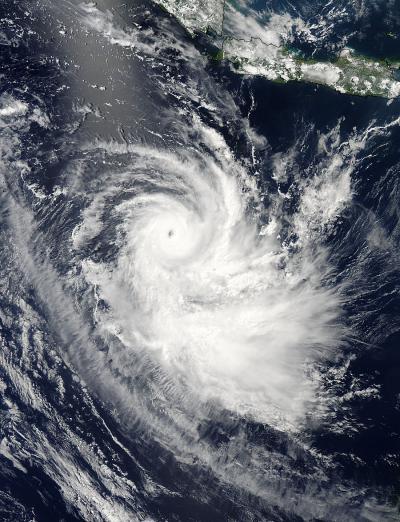Tropical Cyclone Gillian's eye was starting to "close" or become cloud-filled when NASA's Aqua satellite passed over the Southern Indian Ocean on March 23.
On March 23, Gillian's maximum sustained winds peaked near 140 knots/161.1 mph/259.3 kph making it a Category 5 hurricane on the Saffir-Simpson Scale. Fortunately, Gillian pulled away from Indonesia, so all of the regional warnings were canceled on March 23.
At 06:45 UTC on March 23, NASA's Aqua satellite flew overhead and the Moderate Resolution Imaging Spectroradiometer or MODIS instrument captured a visible image of the storm. In the image, Gillian's eye had already started to fill in with clouds and was surrounded by a thick band of thunderstorms wrapping around the center of circulation.
The Joint Typhoon Warning Center noted that satellite data also showed that convection along the northwest quadrant has started to contract and convection in the southeastern quadrant has continued to stretch out. Whenever a storm elongates, it can't maintain its speed and strength, much like a tire going flat.

This visible image of Tropical Cyclone Gillian was captured at 06:45 UTC on March 23 by NASA's Aqua satellite.
(Photo Credit: Image : NASA Goddard Rapid Response Team)
By 09:00 UTC/5 a.m. EDT on March 24, Gillian's strength had waned as maximum sustained winds dropped to 120 knots/138.1 mph/222.2 kph. At that time it was centered near 17.2 south latitude and 103.5 east longitude, about 672 nautical miles/773.3 miles/1,245 km west-northwest of Learmonth, Australia. Gillian was moving toward the south at 10 knots/11.5 mph/ 18.5 kph and generating seas around 40 feet high.
JTWC noted that upper-level northwesterly wind shear has been increasing and is now strong, blowing as high as 30 knots/35.5 mph/55.5 kph. The wind shear is weakening the tropical cyclone. In addition, there is a mid-level trough (elongated area of low pressure) approaching Gillian, and that's creating the sinking or subsidence of air, so that thunderstorms (that make up a tropical cyclone) are unable to develop.
JTWC expects Gillian to continue weakening while tracking south for another couple of days before turning to the west.
Source: NASA/Goddard Space Flight Center